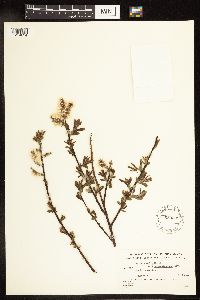Salix humilis var. humilis
|
|
|
|
Family: Salicaceae
Prairie Willow
|
Mid shrubs, 0.3-3 m. Stems usually erect, sometimes decumbent; branches tomentose to glabrescent, peeled wood smooth or striate, striae sometimes very dense, to 20 mm; branchlets red-brown or greenish brown. Leaves: stipules usually foliaceous (rarely rudimentary) on late ones; petiole (1.5-)3-7(-12) mm, velvety or pilose adaxially; largest medial blade narrowly oblong, narrowly elliptic, elliptic, oblanceolate, obovate, or broadly obovate, (20-)50-90(-135) × (7-)13-23(-35) mm, 2.3-4-7.5 times as long as wide, margins strongly revolute to flat, abaxial surface with hairs rarely also ferruginous, adaxial slightly or highly glossy, glabrous, pubescent, or pilose (hairs white, sometimes also ferruginous); proximal blade margins usually entire, sometimes serrulate. Catkins: staminate 14.5-34 × 7-19 mm, flowering branchlet 0 mm; pistillate 9-47 (-55 in fruit) × 5.5-19 mm, flowering branchlet 0-4 mm; floral bract 1.2-2 mm. Staminate flowers: filaments glabrous. Pistillate flowers: ovary obclavate; stigmas 0.24-0.33-0.56 mm; ovules 6-12 per ovary. Capsules 7-12 mm. 2n = 38 and 76. Flowering (north) early Mar-early Jun, (south) late Jan-late Apr. Dry mixed woods and forests, Picea mariana-lichen woods, Picea glauca-Abies balsamea forests, wet to dry prairies, grassy balds, loess bluffs, sandy stream terraces, coastal barrens, Carex-Typha meadows, fine sand to rocky granitic, gneissic, limestone, and serpentine substrates; 20-1600 m; Man., N.B., Nfld. and Labr., N.S., Ont., P.E.I., Que.; Ala., Ark., Conn., Del., D.C., Fla., Ga., Ill., Ind., Iowa, Kans., Ky., La., Maine, Md., Mass., Mich., Minn., Miss., Mo., Nebr., N.H., N.J., N.Y., N.C., N.Dak., Ohio, Okla., Pa., R.I., S.C., S.Dak., Tenn., Tex., Va., W.Va., Wis. See 79. Salix scouleriana and 82. S. atrocinerea for comparative descriptions. Hybrids: Variety humilis forms natural hybrids with Salix bebbiana, S. discolor, S. eriocephala, and S. planifolia. Hybrids with S. discolor or S. planifolia often are suggested by glabrous or glabrate leaves.
Medium-sized shrub to 3 m tall Leaves: alternate, on yellowish to pinkish, 3 - 7 mm long, hairy leafstalks, dark green above, grayish green with a waxy coating (glaucous) beneath, yellowish to pinkish on midrib, 5 - 12 cm long, 1 - 3 cm wide, lance-shaped to oblong lance-shaped with a rounded or heart-shaped base and short-pointed tip, slightly downward-rolled (revolute) and wavy along the margins, irregularly toothed, sometimes minutely hairy above, and hairy and wrinkled beneath (becoming hairless). Young leaves are brownish red, thin, translucent, and minutely hairy. Flowers: either male or female, borne on separate trees (dioecious) in stalkless, cylindrical, hairy catkins. Female catkin green to purplish with blackish scales, 1.5 - 4 cm long. Stigmas red. Ovary densely hairy. Male catkin whitish with blackish scales, 1 - 2 cm long. Stamens two, with red anthers (turning yellow). Fruit: a capsule, in elongated clusters, short-stalked, brownish, 6 - 10 mm long, flask-shaped, and hairy. Seeds have long, white, silky hairs attached. Twigs: yellowish green and hairy. Buds: reddish brown to brown, egg-shaped, flattened, pointed, and slightly hairy. Similar species: In the Chicago Region, Salix humilis var. humilis differs from most other willows by having hairless leaves and downward-rolled (revolute) leaf margins that are not distinctly toothed. Variety tristis is similar to variety humilis but on a smaller scale, with leaves that remain hairy, especially beneath. Salix pedicellaris, a small shrub that grows in bogs and fens, has leaves similar to both S. humilis varieties; however, the leaves of S. pedicellaris are finely net-veined on both sides and have parallel primary lateral veins. Flowering: April to early May, before the leaves Habitat and ecology: Frequent in moist to wet prairies. Also found in open woodlands and sandy areas, especially where there has been a history of fire. Occurence in the Chicago region: native Notes: Planted as an ornamental. Etymology: Salix is the Latin word for willow. Humilis means low-growing. Author: The Morton Arboretum From Flora of Indiana (1940) by Charles C. Deam This is a low, bushy species that grows mostly in dry, sandy habitats, usually in prairies or in similar places. It is frequent in our western prairie area, becoming local in northern and southern Indiana. …… Indiana Coefficient of Conservatism: C = 5 Wetland Indicator Status: FACW |




































































































